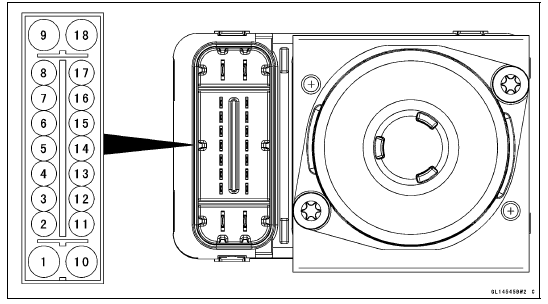


1. Ground: BK
2. CAN Communication Line (High): GY/BL
3. Front Wheel Rotation Sensor Signal Input: Y
4. Power Supply: BR/W
5. KIBS Kawasaki Self-Daignosis System Terminal: P
6. Front and Rear Brake Light Switch Signal: BL/R
7. Unused
8. Front Wheel Rotation Sensor Signal Output: G/Y
9. Power Supply to ABS Solenoid Valve Relay: R/BK
10. Ground to Motor: BK
11. CAN Communication Line (Low): LB
12. Power Supply to Front Wheel Rotation Sensor: W
13. Power Supply to Rear Wheel Rotation Sensor: R
14. Rear Wheel Rotation Sensor Signal Input: G
15. Unused
16. Rear Wheel Rotation Sensor Signal Output: R/Y
17. Unused
18. Power Supply to ABS Motor Relay: R/W
 KIBS System Circuit
KIBS System Circuit KIBS Servicing Precautions
KIBS Servicing PrecautionsBackups
The ECU takes the following measures to prevent engine damage when the
DFI, ignition, S-KTRC
or immobilizer system parts have troubles.
Note:
(1): D-J Method: When the engine load is light like at idling or low
speed, the ECU determines the
injection quantity by calculating fr ...
Self-Diagnosis Outline
The self-diagnosis system is monitoring the following
mechanisms.
DFI System and Ignition System
S-KTRC System
Immobilizer System (Equipped Models)
KIBS and ABS (Equipped Models)
ESD (Electronic Steering Damper) System
(ZX1000JD/KD)
The following warning indicator lights (LED) are used for ...
Chain Slack Inspection
Set the motorcycle up on its side
stand.
Rotate the rear wheel to find the position
where the chain is tightest, and
measure the maximum chain slack
by pulling up and pushing down the
chain midway between the engine
sprocket and rear wheel sprocket.
A. Chain Slack
If the ...